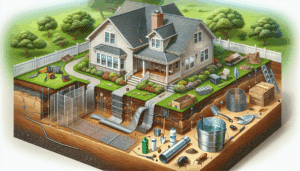Building or renovating a home is a significant investment, and it’s essential to consider long-term factors, including protection against termite infestations. Termites can cause extensive damage to structures, leading to costly repairs and potential safety hazards. In this blog post, we’ll explore the concept of termite-resistant home construction and how you can build for the future by implementing preventive measures.
Contents
Introduction
Hello, future homeowners and builders! When planning your dream home, it’s important to think about more than just aesthetics and functionality. Termite infestations can be a nightmare for homeowners, but with termite-resistant home construction, you can protect your investment and ensure a secure future. In this blog post, we’ll discuss the importance of termite-resistant construction and how to build for the long term.
The Importance of Termite-Resistant Construction
Termites are relentless pests that can go unnoticed until significant damage has occurred. Building with termite resistance in mind offers several advantages:
- Cost Savings: Preventing termite infestations from the outset can save you from expensive repairs down the road.
- Structural Integrity: Termite damage can compromise a home’s structural integrity. Termite-resistant construction ensures a safer and longer-lasting structure.
- Property Value: A termite-resistant home is more attractive to potential buyers and retains its value over time.
Termite-Resistant Building Techniques
Here are some effective techniques for termite-resistant home construction:
1. Use Termite-Resistant Materials
Choose construction materials that are naturally resistant to termites. Pressure-treated wood, naturally durable wood species, and concrete block foundations are excellent options. These materials are less appealing to termites.
2. Create Physical Barriers
Install physical barriers like stainless steel mesh or termite shields around critical entry points, such as pipes, utility lines, and foundation gaps. These barriers block termite access to your home.
3. Implement Proper Grading and Drainage
Ensure that your property has proper grading and drainage to prevent water accumulation near the foundation. Excess moisture can attract termites, so proper drainage is crucial.
4. Maintain an Adequate Distance
When building structures like decks or porches, maintain an adequate distance between wood and soil. Elevate these structures using concrete piers or metal stands to reduce the risk of termite infestation.
5. Regular Inspections
Schedule regular termite inspections during and after construction to detect any signs of termite activity early. Early detection allows for prompt treatment if necessary.
Professional Guidance
While these techniques can significantly reduce the risk of termite infestations, it’s essential to work with a professional pest control company like Arizona Termite Control Company. They can provide guidance on termite-resistant construction methods and conduct inspections to ensure your home remains termite-free.
Conclusion
Building for the future involves more than just aesthetics and functionality; it’s also about protecting your investment and ensuring the long-term safety and integrity of your home. Termite-resistant home construction is a proactive step that can save you from the headache and expense of dealing with termite infestations. By implementing termite-resistant techniques and seeking professional guidance, you can build a secure and resilient home for the future.
For expert advice on termite-resistant construction or to schedule a termite inspection, contact Arizona Termite Control Company at 480-660-3093 or visit arizonatermitecontrol.org.




